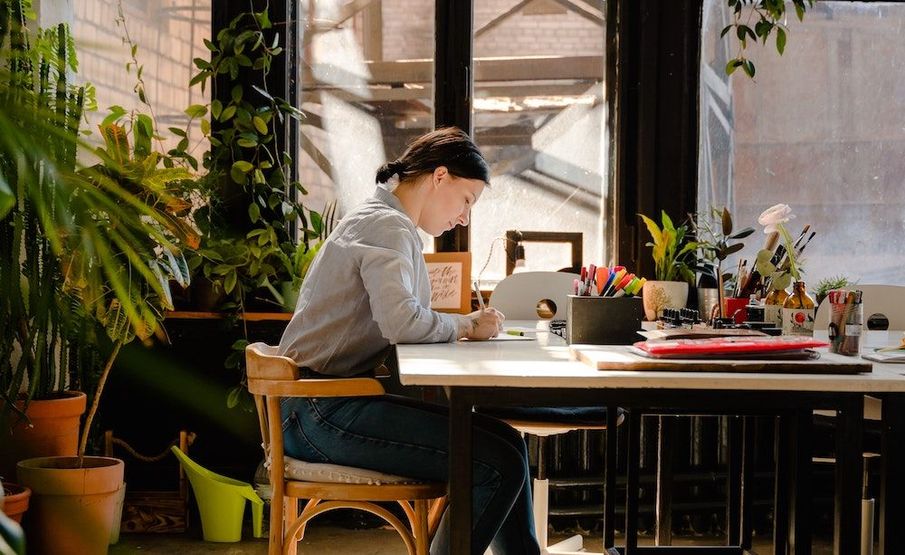Something on your mind? Why not produce, publish, and distribute your own magazine about it? All that creativity is therapeutic, empowering, and fun
Lots of us love getting creative, as a way of supporting our wellbeing and expressing ourselves. And alongside more notable artistic outlets, such as painting and poetry, is the world of zines.
In his fascinating book on zine culture, Notes from Underground, author Stephen Duncombe defines zines as “non-commercial, non-professional, small-circulation magazines which their creators produce, publish, and distribute by themselves”.
Zines often contain a mix of materials: poetry, collage, sketches, first person reflections, advice pieces, photos, lyrics – anything the maker feels like including. There’s no set way to produce them either, as zines may be handmade, with items glued or drawn directly on to the pages, photocopied, or created entirely digitally.
Some people make zines just for themselves, or as gifts for friends. Others print copies to distribute more widely. Increasingly, zines are available to view or buy online on platforms such as Etsy.
For decades, zines have been used to share interests and experiences, from the science fiction zines of the 1930s to the Riot Grrrl zines popular in the 90s. They can be on literally any subject: there are zines available on everything from The Tiny Little Book of Bunny Behaviour to Doing Stuff Outside – a guide for anxious autistics.
Being self-published, zines are a place where we can control the content. This makes them perfect for sharing a diverse range of experiences, such as experiences of marginalised communities.

“We don’t need to fit into anyone else’s framework or rules when we have creative outlets such as zines,” explains counsellor Jane Fellowes. “If we feel passionate about sharing a part of our identity or story, we can then express this in a creative way. This gives us space to tell our own story in a way of our own choosing, not someone else’s. There is great therapeutic value in telling our story, and in this being welcomed and accepted by others.”
Mental health is a common theme in contemporary zines. Author and journalist Erica Crompton started Hopezine after losing two childhood friends to suicide. “I wanted to use my own, and others’, experiences to give hope to all people feeling low or suicidal,” she says. Erica publishes Hopezine quarterly, and it includes a combination of articles, short stories, poetry, and artwork.
“I’ve always believed that writing can help us process difficult feelings,” Erica explains. She also sees Hopezine as an opportunity to give a voice to her friends and colleagues, who may sometimes be overlooked by more traditional forms of media.
"Zines allow us to create something as unique as we are. They are a form of free expression, where parts of ourselves can be explored creatively, and presented with freedom and choice"
The value in zines as a space for marginalised voices is a sentiment shared by professional artist Deborah Rogers. Deborah is the founder of participatory arts organisation The Cultural Sisters, and ran a project with the YMCA encouraging participants to make zines.
“Zines can help provide a voice to someone who might feel voiceless,” Deborah says. “Self-publishing is extremely empowering, and this is where zines came and grew from.”
Zines are one of my favourite creative activities. I find it cathartic to have this space where I can write candidly about my experience of disability and mental ill-health. One of the great things about zines is how you can use different artistic techniques. On one page I can include a poem, on another a collage of words taken from doctors’ notes, rearranged to reflect and subvert how alienating these notes can feel.
“I feel zines allow us to thoroughly explore an issue, each page looking at it from another angle, using a different material or technique, to look at the issue differently,” explains Deborah.
“Zines allow us to create something as unique as we are,” says counsellor Jane. “They are a form of free expression, where parts of ourselves can be explored creatively, and presented with freedom and choice.”
I’ve also made zines as gifts for friends, the pages full of things meaningful to us. Many people share their zines more widely. Erica posts print copies of Hopezine to friends and family, and then around 700 PDFs go out to her colleagues, past and present. She also sells them on her Etsy shop, and archives them on Hopezine.com.

The power of zines comes, too, from their ability to connect communities. “Zines can help you feel listened to and valued,” Deborah says. “They can help link people together, or be a voice to the community.”
Zines are a feature of many subcultures because of this ability to connect people. It can be really validating to read a zine that resonates with your own experience.
“They provide us with something to focus on which will be of interest and value to others, which can give us a sense of purpose and meaning,” explains Jane. “Creativity provides an outlet for us to explore, be, and express our true selves.”
Make your own zine
A good way to start is to decide what you want your zine to be about. Try thinking of a theme, such as ‘living with anxiety’ or ‘my favourite family recipes’. Consider if it is a project for yourself, a gift, or do you like the idea of distributing it?
Zines can contain a range of creative techniques. One of my favourites is using ‘found objects’: items we are all surrounded by. This can be newspaper cuttings, old train tickets, receipts – anything goes! These can be kept whole or arranged into collages.
If you feel stuck, try “free writing”. Take 10 minutes to sit with your notebook and write. You could use a key word or phrase that summarises the theme for your zine as a starting point.
Maybe you have illustrations or photos you’d like to include? Lists are also great to use. It could be music you’re listening to, places you want to visit, stereotypes you want to challenge, or your ambitions.
The other consideration is how you will put it together. I like using quality A4 paper folded into an A5 booklet. Once it’s done, and I’ve made any photocopies, I staple these in the middle. I once used thread to bind it – which looked beautiful, though sewing paper is time consuming and fiddly! There are also various paper-folding techniques, with lots of guides available online.
Plus you can create zines electronically. Erica’s Hopezine is a great example of this, and she provides both PDF and printed versions of the finished work.
You could, like Erica, collaborate with others. Do you have friends who write poetry, or create artwork? Some zine creators post callouts for contributions online. This is a great way of bringing together diverse voices around a theme, again building the sense of community.
There is no right way to make a zine, so relax, and enjoy creating something that’s personal and a perfect space for exploring your experiences.
To connect with a life coach, or to learn more about the power of zines and creative writing, visit lifecoach-directory.org.uk


Comments